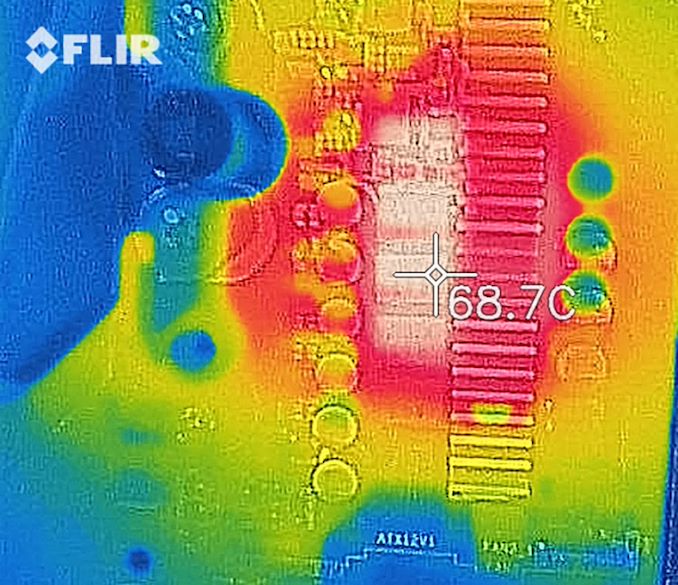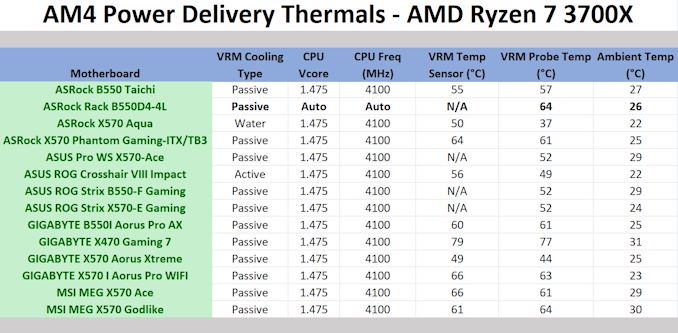ASRock Rack B550D4-4L Motherboard Review: B550 Goes Professional with BMC
by Gavin Bonshor on May 20, 2021 9:00 AM ESTPower Delivery Thermal Analysis
One of the most requested elements of our motherboard reviews revolves around the power delivery and its components. Aside from the quality of the components and its capability for overclocking to push out higher clock speeds which in turn improves performance, is the thermal capability of the cooling solutions implemented by manufacturers. While almost always fine for users running processors at default settings, the cooling capability of the VRMs isn't something that users should worry too much about, but for those looking to squeeze out extra performance from the CPU via overclocking, this puts extra pressure on the power delivery and in turn, generates extra heat. This is why more premium models often include heatsinks on its models with better cooling designs, heftier chunks of metal, and in some cases, even with water blocks.

The CPU section of the 6-phase (4+2) power delivery on the ASRock Rack B550D4-4L motherboard
Testing Methodology
Out method of testing out if the power delivery and its heatsink are effective at dissipating heat, is by running an intensely heavy CPU workload for a prolonged method of time. We apply an overclock which is deemed safe and at the maximum that the silicon on our AMD Ryzen 7 3700X processor allows. We then run the Prime95 with AVX2 enabled under a torture test for an hour at the maximum stable overclock we can which puts insane pressure on the processor. We collect our data via three different methods which include the following:
- Taking a thermal image from a birds-eye view after an hour with a Flir Pro thermal imaging camera
- Securing two probes on to the rear of the PCB, right underneath CPU VCore section of the power delivery for better parity in case the first probe reports a faulty reading
- Taking a reading of the VRM temperature from the sensor reading within the HWInfo monitoring application
The reason for using three different methods is that some sensors can read inaccurate temperatures, which can give very erratic results for users looking to gauge whether an overclock is too much pressure for the power delivery handle. With using a probe on the rear, it can also show the efficiency of the power stages and heatsinks as a wide margin between the probe and sensor temperature can show that the heatsink is dissipating heat and that the design is working, or that the internal sensor is massively wrong. To ensure our probe was accurate before testing, I binned 10 and selected the most accurate (within 1c of the actual temperature) for better parity in our testing.
For thermal image, we use a Flir One camera as it gives a good indication of where the heat is generated around the socket area, as some designs use different configurations and an evenly spread power delivery with good components will usually generate less heat. Manufacturers who use inefficient heatsinks and cheap out on power delivery components should run hotter than those who have invested. Of course, a $700 flagship motherboard is likely to outperform a cheaper $100 model under the same testing conditions, but it is still worth testing to see which vendors are doing things correctly.
Thermal Analysis Results

We measured 68.7ºC on the hottest part of the power delivery during our testing
The power delivery on the B550D4-4L is using premium components but isn't adequately cooled for performance users. It features a 4+2 phase power delivery, which is driven by an Intersil ISL69247 PWM controller, which is capable of handling up to eight channels. The CPU section is located on the opposite side of the board from the SoC area, and ASRock Rack includes four Renesas ISL99390 90 A power stages designed to deliver a maximum of 360 A to the processor. The SoC section is using two Renesas ISL99390 90 A power stages.
The ASRock B550D4-4L motherboard is using premium components for its 6-phase power delivery, with each phase consisting of a Renesas ISL99390 90 A power stage. It is controlled by an Intersil ISL69247 PWM controller operating in a 4+2 configuration. Boards such as these are typically built to specification, without the glorification of high-end components and over-engineered designs. As a result of the lack of optimal heatsinks designed to keep it cool, we only tested the board at stock settings. Despite offering some overclocking functions in the firmware via the way of AMD's own enhancements, and even boldly including an 'LN2 mode', the heatsinks cooling the power delivery aren't substantial enough to support overclocking. The heatsinks themselves are slithered thin, with little to no mass, and are standard on professional-focused models such as this.
As we tested the B550D4-4L at default settings, and we saw acceptable power delivery thermal for a board of this caliber. We observed temperatures of 62 and 64 degrees Celsius respectively from our pair of K-type thermocouples, with the hottest part of the CPU section of the power delivery coming in with a maximum temperature of 68.7 degrees Celsius. The board doesn't include an integrated power delivery thermal sensor, so we couldn't take this reading.
Although the B550D4-4L does include options for customization of Precision Boost Overdrive, power settings, and basic overclocking functions, our results suggest that it wouldn't be wise, nor prudent to push any processor on this board further than the default settings. Our testing shows that when compared to other AM4 boards we tested, the temperatures at default settings were similar to the board's tested with a CPU VCore of 1.475 and overclocked all-cores to 4.1 GHz. This is another testament as to why this board isn't really suitable for overclocking.











73 Comments
View All Comments
im.thatoneguy - Thursday, May 20, 2021 - link
Please stop putting 10g ports one servers.They're always 10-BaseT which is useless to me. They take up pcie lanes. And 25gb/40gb/100gb is imminently supplanting 10gb.
It's too late for 10g especially baseT
fmyhr - Thursday, May 20, 2021 - link
Heh. I agree with you about 10-BaseT, SFP+ would be preferable if 10GbE *needs* to be present. I don't have $ or power budget for 25gb/40gb/100gb network... but understand those are requirements for some. I'm curious how your ideal board would allocate its limited PCIe lanes among PCIe slots, M.2 slots, OcuLink,...?bananaforscale - Saturday, May 22, 2021 - link
10GBase-T uses the same cabling as 1000Base-T, assuming the network was built with any future proofing so you can basically just plug it in. 25GBase-T probably won't happen. 'sides, YOU are not the market. What's useless to you is probably useful for someone. Also besides, you can disable those integrated NICs.mode_13h - Saturday, May 22, 2021 - link
> 10GBase-T uses the same cabling as 1000Base-T,> assuming the network was built with any future proofing
Depends on when. It might've been built with Cat 6, rather than Cat 6A. And even that has shorter length limitations and requires greater power expenditure than we're used to with Gigabit.
BTW, there's no such standard as Cat 6e. If you see someone selling cable as Cat 6e, treat it as plain Cat 6, but with a bit more suspicion.
Samus - Thursday, May 20, 2021 - link
I think 2x2.5G would be more appropriate for the target market of this board. Anybody considering 10Gbe is likely on the verge of adopting 25/40/100G anyway, in which case the PCIe slot will be utilized.The other head scratcher is why the M2 slot isn’t PCIe 4.0 - the allocation of PCIe lanes to ports on this board is very strange.
fmyhr - Thursday, May 20, 2021 - link
Do you have personal experience running 2.5GbE? I've seen reports of problems using both Intel and Realtek chipsets. Whereas 10GbE is very mature and well-supported. Upside of being "obsolete" :-)This board runs the M.2 slot from the B550 chipset, which limits its speed to PCIe 3.0. The upside of this choice is an extra PCIe 4.0 x4 slot from the CPU. Into which you could install an M.2 carrier board if you need your SSD on PCIe 4.0. Personally I'd try bifurcating the PCIe 4.0 x16 slot and running a quad M.2 card there, and whatever other PCIe card in the x4 slot.
lightningz71 - Thursday, May 20, 2021 - link
Does this board even support 4way bifurcation of the PCIe x16 slot?Samus - Friday, May 21, 2021 - link
The B550 can't bifurcate the x4 slot, but it apparently can the x16 slot. In the case of some boards with multiple PCIe 4.0 NVMe M.2 connectors, they start by cutting the x16 slot bandwidth, then after a third M.2 drive is installed they either totally disable the x4 slot or run the x16 slot at x4, configurable in the BIOS (in the case of the Gigabyte B550 Aurus Master)Samus - Friday, May 21, 2021 - link
Personally no I'm not running any 2.5G stuff, and based on what you are stating, maybe that's why there hasn't been adoption. I agree going with a mature solution but 2.5G isn't exactly new and by now you'd think the bugs are worked out. 2.5G is, after all, based on a lower handshake of 10Gbe, and at long distances 10Gbe actually negotiates at 2.5G, and I have installed 2.5G cards in the field that connect to 10Gbe ports at 2.5G. It's the damn SFP adapters that are all proprietary with their individual standards so you just need to make those up with whatever chipset the NIC you are connecting has.Regarding NVMe on B550, I'm not sure what you are getting at. There have been B550 boards on the market for over a year that have not one, not two, but three native PCIe4 NVMe M.2 slots direct from the chipset. Obviously having many M.2 slots impedes on other PCIe x4\x8\x16 slot bandwidth because the consumer Ryzen's don't offer many lanes. But that doesn't mean this board should leave support out entirely as the M.2 could just cut into the x4 or x16 slot bandwidth.
mode_13h - Friday, May 21, 2021 - link
> Do you have personal experience running 2.5GbE?Well, the main benefit is cable length and compatibility. If the speed is fast enough for you, then it seems an attractive option for those with legacy cabling.